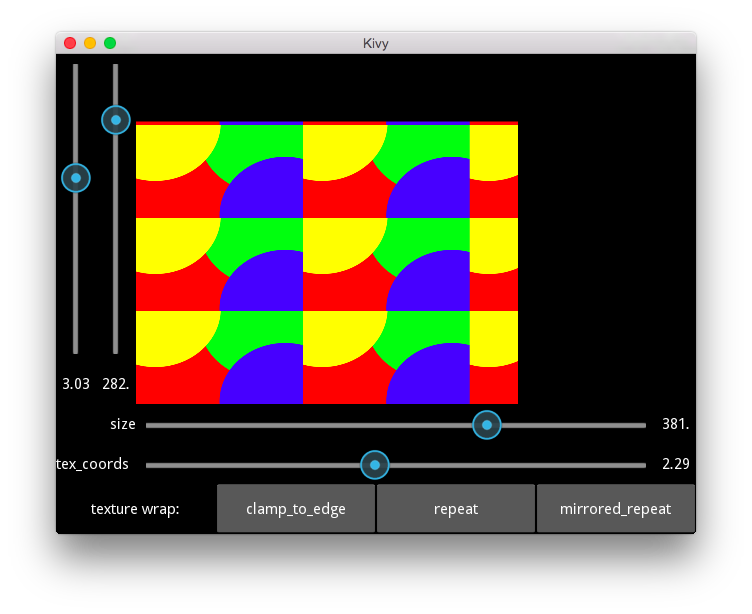Table Of Contents
Texture Wrapping and Coordinates Example¶
This example changes texture properties and the properties of its containing rectangle. You should see some a multicolored texture with sliders to the left and below and buttons at the bottom of the screen. The image texture_example_image.png is rendered into the rectangle. Sliders change the number of copies of the texture (the tex_coords), the size of enclosing rectangle (the taw_height and taw_width) while the buttons change how the texture is rendered when more than one copy is in the rectangle (the texture_wrap).
File canvas/texture.py¶
'''
Texture Wrapping and Coordinates Example
========================================
This example changes texture properties and the properties
of its containing rectangle. You should see some a multicolored
texture with sliders to the left and below and buttons at the
bottom of the screen. The image texture_example_image.png is
rendered into the rectangle. Sliders change the number of copies of the
texture (the tex_coords), the size of enclosing rectangle (the taw_height
and taw_width) while the buttons change how the texture is rendered when more
than one copy is in the rectangle (the
texture_wrap).
'''
from kivy.uix.widget import Widget
from kivy.properties import ObjectProperty, ListProperty, StringProperty
from kivy.lang import Builder
from kivy.clock import Clock
from kivy.base import runTouchApp
class TextureAccessibleWidget(Widget):
texture = ObjectProperty(None)
tex_coords = ListProperty([0, 0, 1, 0, 1, 1, 0, 1])
texture_wrap = StringProperty('clamp_to_edge')
def __init__(self, **kwargs):
super(TextureAccessibleWidget, self).__init__(**kwargs)
Clock.schedule_once(self.texture_init, 0)
def texture_init(self, *args):
self.texture = self.canvas.children[-1].texture
def on_texture_wrap(self, instance, value):
self.texture.wrap = value
root = Builder.load_string('''
<TextureAccessibleWidget>:
canvas:
Rectangle:
pos: self.pos
size: self.size
source: 'texture_example_image.png'
tex_coords: root.tex_coords
<SliderWithValue@BoxLayout>:
min: 0.0
max: 1.0
value: slider.value
Slider:
id: slider
orientation: root.orientation
min: root.min
max: root.max
value: 1.0
Label:
size_hint: None, None
size: min(root.size), min(root.size)
text: str(slider.value)[:4]
BoxLayout:
orientation: 'vertical'
BoxLayout:
SliderWithValue:
orientation: 'vertical'
size_hint_x: None
width: dp(40)
min: 0
max: 5
value: 1
on_value: taw.tex_coords[5] = self.value
on_value: taw.tex_coords[7] = self.value
SliderWithValue:
orientation: 'vertical'
size_hint_x: None
width: dp(40)
min: 0
max: taw_container.height
value: 0.5*taw_container.height
on_value: taw.height = self.value
AnchorLayout:
id: taw_container
anchor_x: 'left'
anchor_y: 'bottom'
TextureAccessibleWidget:
id: taw
size_hint: None, None
BoxLayout:
size_hint_y: None
height: dp(80)
BoxLayout:
orientation: 'vertical'
size_hint_x: None
width: dp(80)
Label:
text: 'size'
text_size: self.size
halign: 'right'
valign: 'middle'
Label:
text: 'tex_coords'
text_size: self.size
halign: 'left'
valign: 'middle'
BoxLayout:
orientation: 'vertical'
SliderWithValue:
min: 0
max: taw_container.width
value: 0.5*taw_container.width
on_value: taw.width = self.value
SliderWithValue:
min: 0.
max: 5.
value: 1.
on_value: taw.tex_coords[2] = self.value
on_value: taw.tex_coords[4] = self.value
BoxLayout:
size_hint_y: None
height: dp(50)
Label:
text: 'texture wrap:'
text_size: self.size
valign: 'middle'
halign: 'center'
Button:
text: 'clamp_to_edge'
on_press: taw.texture_wrap = 'clamp_to_edge'
Button:
text: 'repeat'
on_press: taw.texture_wrap = 'repeat'
Button:
text: 'mirrored_repeat'
on_press: taw.texture_wrap = 'mirrored_repeat'
''')
runTouchApp(root)
Image canvas/texture_example_image.png¶


